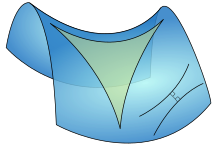Saddle surface

In geometry, a saddle surface is a surface that is opposite in the two main directions - i.e. H. anticlastic - is curved. Your Gaussian curvature measure is negative.
Its name comes from the horse saddle or the saddle in the field , which at the same time represents a transition between two mountains and two valleys.
Examples of saddle surfaces
A well-known saddle surface is a hyperbolic paraboloid . Such a surface is created by connecting opposing edges of a three-dimensional square evenly with threads. Such a surface can be generated by moving a straight line in space (it is a ruled surface ). Another generation of a hyperbolic paraboloid is the geometric location of all points that are equidistant from two crooked straight lines in space.
Further special cases are minimal surfaces in which the two main curvatures are opposite and equal.
Geometric properties

The angle sum of a triangle on a saddle surface is - in contrast to a spherical triangle or generally a triangle on a positively curved surface - less than 180 ° (see adjacent sketches).
The Gaussian degree of curvature of the saddle surface is negative, that on a sphere or ellipsoid is positive. Therefore, the geometry on these surfaces differs from the Euclidean geometry in the plane, which has zero curvature.
